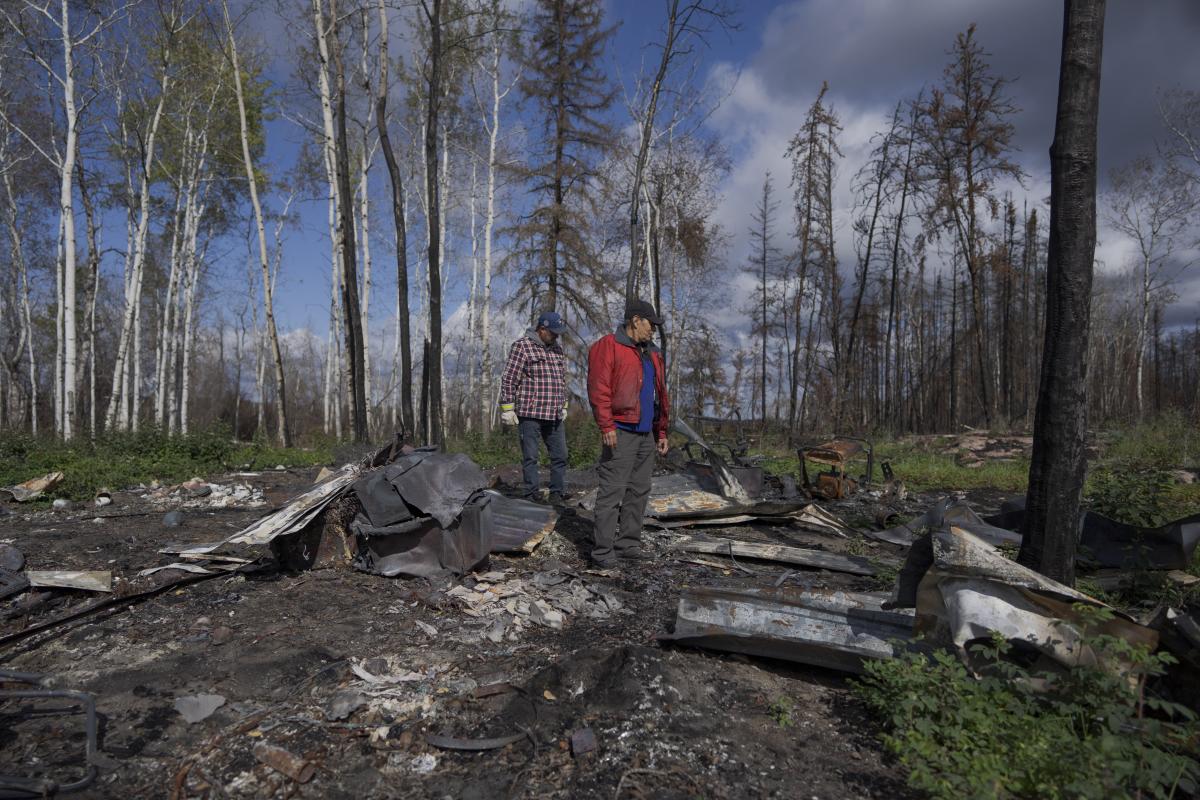FORT MCMURRAY, Canada (AP) — In the midst of a fierce May wildfire that ravaged a vast expanse of spruce and pine forest in northwestern Canada, Julia Cardinal suffered the loss of a riverside cabin that held deep significance for her. It was not just a retirement project; it was a cherished gift from her husband, and a place deeply connected to her family’s legacy of living in harmony with nature for generations.
“That was our dream home,” lamented Cardinal, a member of the Athabasca Chipewyan First Nation. “It’s like a displacement.”
Canada has seen thousands of wildfires this year, scorching an area larger than Florida and releasing more than three times the amount of carbon dioxide produced by Canada in an entire year. Some of these fires are still raging.
Leaders of Canada, including liberal Prime Minister Justin Trudeau, have consistently emphasized the dual goals of exploiting natural resources while working to protect biodiversity and leading the global fight against climate change. However, the seemingly unending fire season has brought to light a growing tension within Canada – the struggle to balance the commitment to fighting climate change with its status as one of the world’s top oil and gas producers. The use of these fuels releases carbon dioxide, a greenhouse gas that traps heat in the atmosphere and intensifies the dry conditions leading to widespread wildfires that consume millions of acres.
“They’re portraying Canada as environmental,” said Jean L’Hommecourt, an environmental advocate from the Fort McKay First Nation. “But the biggest source of the carbon is here.”
OIL FOCUS AND ADVOCACY
Canada is among the nearly 100 nations that have pledged to achieve “zero emissions” by midcentury. Additionally, at last year’s U.N. climate conference, known as COP27, Canada joined other wealthy nations in promising more funding for developing countries to combat climate change.
Analysis by The Associated Press found that, however, Canada brought the second-largest delegation of fossil fuel executives of any country in the world to this very conference. Eleven executives from major Canadian oil, gas, and steel companies, including Enbridge and Parkland Corporation, attended COP27 – a conference dedicated to setting climate priorities and timelines for reducing emissions of greenhouse gases. The only country to send a larger delegation of fossil fuel executives was Russia, according to AP.
“We’re not there to drive an agenda, but we do have a perspective to offer,” said Pete Sheffield, chief sustainability officer at pipeline and natural gas giant Enbridge Inc., echoing what other Canadian energy executives told The AP about their attendance at COP27.
According to Canadian oil producers’ perspective, even though they continue to extract oil at current rates, and with the aid of technology, optimize their operations for the country to meet its climate goals, they fail to account for the greenhouse gas emissions when customers use their products for various purposes such as powering cars, heating homes, and taking flights.
OIL, FIRES AND SMOKE
In the western province of Alberta, where numerous intense wildfires blazed, lies substantial deposits of thick crude oil mixed with tarry sand. The extraction from this area, known as the “oil sands,” is highly energy-intensive, making Canada’s oil, most of which is extracted here, among the world’s most environmentally damaging.
In Alberta, the industry’s impact on the landscape is profound: over an area larger than New York City, oil companies have dug open-pit mines plunging hundreds of feet deep, created lake-sized chemical runoff pools, and left eerie stacks of neon yellow sulfur byproduct.
At certain times, the fires in Alberta ravaged so closely that oil companies had to temporarily halt oil and gas production, impacting the well-being of the average Canadians who were unable to safely breathe the air.
Regardless of these challenges, Canadian producers have no intention of slowing down. Since 2009, oil sands extraction has continued to expand with Canada now producing approximately 4.9 million barrels of oil a day. Oil and gas currently contribute to almost a third of the country’s emissions in 2021.
SUSTAINABLE FUTURE?
Canada’s justification for producing such high levels of oil and gas in the 21st century is based on its status as a stable democracy with stricter environmental and human rights laws than other oil giants the West has historically relied upon. Canada is the largest foreign supplier of oil to the U.S., exporting an amount equal to 22% of U.S. consumption.
However, climate scientists caution that maintaining current extraction levels will prevent Canada from achieving net zero emissions. Moreover, the additional contributions to climate change from wildfires, which scientists predict will burn more and longer as the planet warms, pose a significant obstacle.
Scientists at Climate Action Tracker, a group that scrutinizes nations’ pledges to reduce emissions, have labeled Canada’s progress as “highly insufficient,” emphasizing the urgent need for Canada to implement its climate policies much faster.
These wildfires will compound the challenge of cutting emissions and pose significant health hazards to Canadians and anyone exposed to the smoke.
Last June, a fire neared the subarctic, predominantly indigenous hamlet of Fort Chipewyan in northern Alberta. In the midst of the blaze, Julia Cardinal and her husband Happy Cardinal lost their cabin, located about a 45-minute boat ride away.
While the trauma of the fire remains fresh, the couple’s sentiments are complex. Despite recognizing the role of climate change in the fires and the impact of oil on the climate and local lakes and rivers, they are not swift to assign blame to the industry. Happy Cardinal was an oil sands worker until his retirement three years ago.
___
AP data journalist Mary Katherine Wildeman contributed to this report.


